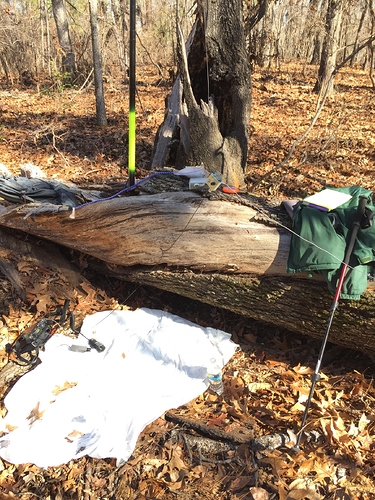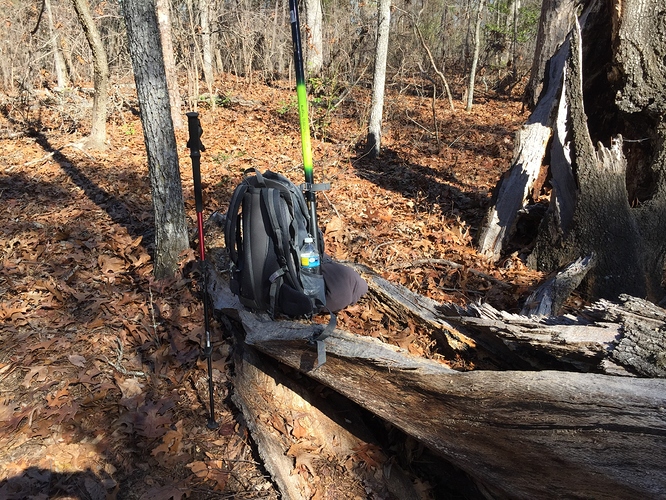Since there are no qualifying Summits within about a 2 hour drive from home, decided to try some chasing from a local state park to at least get out in the woods. Figured I could also test out my gear for when I do get to go to a summit. This included transport, setup, use, teardown and making sure everything was accounted for before departing.
I had just finished building my SOTA Tuner and thought this would also be a good time to test it. I’d had a couple of impromptu chasing events while testing antennas in the park, so figured it would be a good field test for the tuner.
Everybody is probably already familiar with the Hendricks SOTA Tuner, so I don’t need to add details on that one. If not, the link is:
I’d also bought a 20 foot (about 6 meters) fishing pole that would work with the tuner to get both horizontal and vertical radiation. Plus I just like to play with antennas.
So last Wednesday I packed up the 817, new tuner, pole, other accessories and 6.4 Ah LiFePo 12v and headed to the park. I’d already adjusted the approximate antenna and counterpoise wire lengths to the tuner with my MFJ 259 analyzer and made simple knots at the correct lengths for each band. After extending to the proper length for a particular band, I just rolled the remaining length of wire into a quick coil. With all the other variables involved, I didn’t think this would hurt the antenna that much. Besides being much quicker to change bands, I figured it would allow more contacts instead of spending the time switching and configuring wires. The tuner handled it ok, will have to have a few tests to see if it helps or hurts.
After arriving at the park and hiking to a relatively high area I found a nice fallen tree to use as a backrest and lash the pole to.
The pole is visible lashed to the tree, the blue bungee wasn’t needed, so it’s just relaxing. The 817 is on the left of the glaring white rain poncho serving as a ground cloth. Had both the mic and Palm paddles hooked to the 817. The tuner is visible near the center with the gray antenna wire running up to the top of the pole and over to a tree. The white counterpoise wire runs off to the lower right. A few accessories are on the log, with the white blob on my jacket being the logbook. Wx was sunny and about 60 deg F, so a great day to be out.
The tuner worked really well, and the small LED was very visible in the direct sunlight. Very easy to see the dimming effect when tuning. The sweet spot is pretty sharp when tuning, but easy to get the dim indication. Given the small components inside, I did expect the tuning to be a bit sharp. When in the “Operate” switch setting the noise peak was easy to hear. Very satisfied with the tuner’s operation and ease of use. Especially after starting with a bag of parts. I know I’m preaching to the choir, but it’s hard to beat the fun of having something you build yourself perform as planned. The SWR dip was also evident on the 817’s meter.
I do enjoy the 817, but one day looking at a KX2. Those were pretty expensive, so I spent a few bucks with W4RT to upgrade the CW/SSB filters and battery system. A bit expensive, but nowhere near the price of a new KX2/3. Plus I still use 2m/440 on the 817. Definitely helps the receive and the new battery system is great. Don’t get me wrong, I’d love to spring for a new KX2/3, just not yet.
After testing the antenna and field setup for the whole system, it turned out that the bands were terrible on Wed. The INTERCON net could barely hear me, but they were having trouble with a lot of other stations as well. Same for the Maritime Mobile net. I mainly tried 20m due to time limits, with a quick try on 17m. No spots were showing while I was out, and the nearest alert was for after I had to leave for other errands on my day off. At least the antenna got a good test and the tuner/antenna combo integrated well with the rest of the system. Felt good to be heard even in bad cndx, even though decent QSOs were hard. Plus I got to get out in the woods and enjoy a really nice day. The whole setup played well together, which was one reason for going out.
The whole works packs up fine in my fairly small pack, and the pole fits well strapped to the side
As a final note, I’d really recommend pulling everything out of the pack every now and then to look things over. I usually keep the 817 and accessories in a case in my truck. While pulling some pieces out, I noticed the old 817 NiCd battery pack in the bottom had started to corrode. Instant panic, but it was in a separate compartment than the radio, and none of the accessories were damaged. I use the pack a lot, and never thought to look in the very bottom. Hope this saves someone some grief.
Overall a very nice hike in the woods on a great day to be out. Got to play radio and even got a nap in while relaxing in the sun. Will try again to do same chasing. I’m sure a weekend would have better luck, but have to take the days off when you get them. Had a blast, and can’t wait to try it again.

